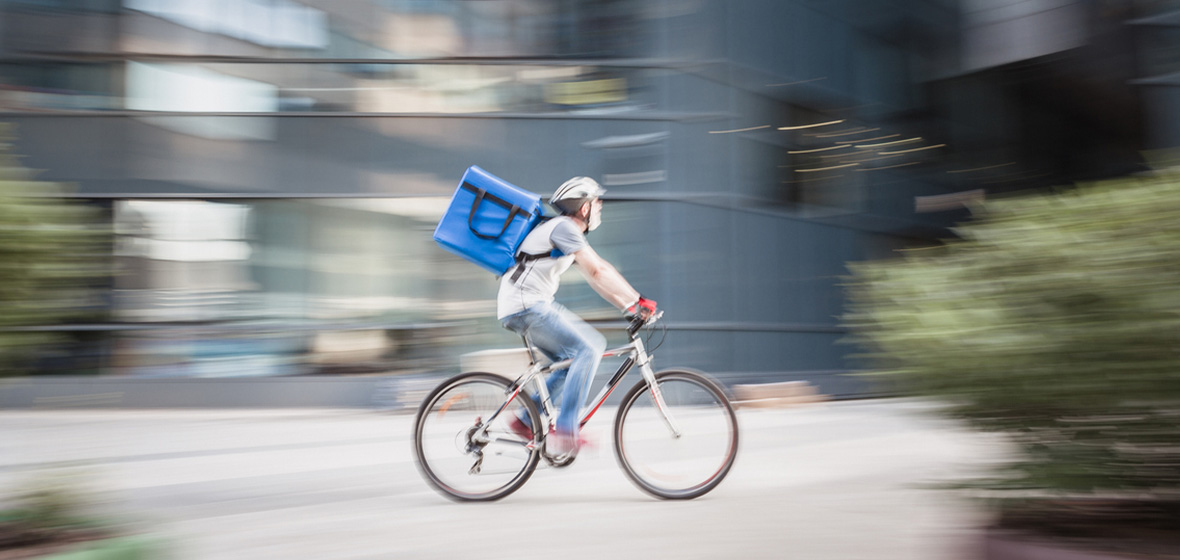The recent closure of delivery service MilkRun re-awakens questions about the employment status of workers in a gig-economy delivery service, and what this means for the employer's liability.
Last week saw the closure of rapid-delivery service MilkRun, with the loss of about 400 jobs. Founded in 2021, MilkRun differed from many similar businesses in that it was not a part of the so-called “gig economy”, a blanket term for companies which typically don’t use permanent staff, but instead use “contractors”, who don’t have a guaranteed minimum wage and access to employment rights. From the pickers at its hubs to its riders on the roads, all MilkRun’s workers were employees. As a result, its labour costs were higher than gig-economy delivery services.
In some areas, MilkRun was reportedly losing $13 on each order. El Leverington, an associate at Slater and Gordon’s Industrial and Employment practice, says, “It seems telling that a company that’s trying to operate ethically and pay people a living wage actually can’t afford to continue to exist.”
Leverington’s first professional job was working for a firm that did mostly employment law but largely acted for employers. “I enjoyed the work,” she says, “but it didn’t … sit well with me.” As a boarder at Loreto Normanhurst, she had always been involved with social-justice projects, and she had tried to keep up volunteering after she graduated from the University of Notre Dame. When her father passed away in 2017, she took a year out of the law and, after a period of soul searching, decided, “I really like the employment-law thing, but maybe I’d like to be in the other corner.”

In October 2019, Leverington joined Unions NSW as a legal/industrial officer and “loved it”, she says.
Injured in the course of work
That same month, Leverington was waiting at the lights at an intersection in Glebe, Sydney, when “a guy riding a scooter was taken out by a driver who ran a red light”, she says. “It was the Christmas-party season. She pulled over and it turned out she was quite pissed.”
Leverington and others stopped to help the rider, whose bag bore the logo of a delivery platform. She asked him if she should call the platform, but the rider said “no”.
“The poor guy had been collected; he was on the road,” says Leverington.
He phoned his cousin, who arrived quickly.
“The first thing his cousin did was log him off the platform,” says Leverington. “Because otherwise his wait time would have been blown out and the algorithm would’ve been affected, and that would’ve affected his ability to get work in the future.
“It was hard to watch.
“Then we called an ambulance,” says Leverington. “They checked him out and, for whatever reason, he didn’t want to go into the ambulance. I just thought, ‘How horrific that someone’s injured in the course of work, and it even crosses their mind that they wouldn’t get treatment!’”
Much of Leverington’s work for the union movement involved the gig economy, of which delivery riders and rideshare drivers are only the most visible aspect. Care-providing platforms offer a service connecting patients with disability-care workers. Whizz and Helpling bring cleaners together with clients. Businesses such as Airtasker encourage freelancers to compete for work by bidding down on jobs.
As the workers engaged through the platforms are generally held to be independent contractors rather than employees, they have negligible employment rights and can easily find themselves making less than the minimum wage.
“The average Uber driver is technically an independent contractor,” says Leverington, “but it’s pretty blurry. A contractor should be able to delegate work. With Uber, you can’t just say to your brother, ‘Hey, can you drive for the day? Can you do this job?’”
In a 2020 case, Amita Gupta v Portier Pacific Pty Ltd; Uber Australia Pty Ltd t/a Uber Eats [2020] FWCFB 1698, Uber successfully argued that it had no employment relationship with its riders, but the court also found there was not an independent-contractor relationship. It was unclear who then had the obligation to provide a safe workplace for periodically abused and put-upon Uber drivers.
A dangerous ride
But delivery riders have it worse. “It is an incredibly dangerous job, particularly in major cities,” says Thomas Costa, an assistant secretary at Unions NSW. Late in 2020, three delivery riders were killed on Sydney roads inside three months.

“You’re riding a bike on the road and that’s dangerous in itself,” says Costa, “but the gig companies add more danger to the job, by creating a competitive environment in which the riders are forced to race against the clock to make more money.
“If you ride for Uber Eats, the algorithm doesn’t guarantee that you’ll have a shift from week to week. To ensure that you get good shifts – the night-time/dinner-time hours – you need to show that you log on frequently and that you stay logged on for a longer period of time.
“That means when it’s raining on a Monday night and you choose not to log on, you’re likely not to get a shift the following week. So you’ve got to log on. And then you’ve got to ride in the rain, and you’ve got to do deliveries at a certain speed, and you can’t say, ‘I did it slower because it was really unsafe’, because then the algorithm will knock you down the list and you won’t get the good shifts. So you are kind of forced into riding in dangerous conditions, running red lights and things like that.”
Lawyers’ knowledge about employment rights has become increasingly important to unions. “The whole industrial system has become very complicated,” says Costa. “The approach of the Fair Work Commission has become far more technical. Commissioners and members of the tribunal have higher expectations of the way advocates appear in that jurisdiction. It’s not technically meant to be a jurisdiction for lawyers or one that adheres to the rules of evidence, but increasingly it does adopt those approaches.”
The gig economy presents perhaps the biggest challenges.
“The gig economy exploits loopholes within the Fair Work legislation,” says Costa. “You need very smart and hard-working lawyers to identify what kind of approach has been taken by the gig company to engage those workers, and then think quite strategically about how you’re going to represent them when the whole way we were constructed is to represent traditional employees.
“Gig workers don’t have rights to collective bargaining, so they can’t take protected industrial action. How do you negotiate with a big company, and force them to negotiate with their workforce, when you just don’t have the same collective bargaining rights?”
One tool available is the law.
Leverington joined Slater and Gordon in February 2021, working extensively on gig-economy occupational-health-and-safety issues. She says the time pressures on some delivery riders are such that they can’t afford to take a bathroom break. “There’s no humanity in feeling like you can’t stop for five minutes to pee,” she says, “because that will have a flow-on effect that you get less jobs.”
But, of course, pay remains hugely important, too.
Leverington says she regularly passes a homeless man sleeping rough in Woolloomooloo. “He has a decent set-up, to be fair,” she says. “He has a shelter and a mattress and stuff. And he’s got a bike there with a branded delivery bag on. Obviously, there’re many factors that might contribute to someone sleeping rough, but if he’s working and it’s not a wage that he can afford to be housed on, it’s a real problem.”
To date, says Leverington, lawyers and the unions have been fighting exploitation on a case-by-case basis, but they have to also advocate for change and “push for things to get better”.
She says, “We’re trying to nut out these issues and build precedents on a case-by-case basis, and then hopefully get a more structural change.
“Slaters has had some success with compensation for workplace deaths in the gig economy,” Leverington adds.
Painting a simple picture of a worker
On 29 December 2020, Chinese migrant Xiaojun Chen was hit by a bus and killed while he was delivering for Hungry Panda. Slater and Gordon pursued a death-benefit claim on behalf of Chen’s family. The case was taken by the then practice group leader Jasmina Mackovic, who is now a special counsel at LHD Lawyers.
“When there is a gap in law, you always hope that there’s a case that has those perfect circumstances that allow you to open that gate so that you get the right decision,” says Mackovic. “We’re not always lucky enough to have those right facts.”

“A lot of gig-economy workers work for a few different companies, and having multiple jobs complicates the situation. In the Hungry Panda case, the deceased worker only worked for Hungry Panda, which allowed us to paint this simple picture: this is what he did for his job, and this is all he did.
“The insurer declined the claim from the outright,” says Mackovic. “They declined it when we submitted further information. They were trying to speak to colleagues of the deceased worker to get information from them because, once someone dies, a lot of the information dies with them.
“There was a lot of back and forth,” she says, “but once we dug up everything we could, and said, ‘This is it’, we took it to the Personal Injury Commission so that it could be formally determined one way or another. And the Friday before the hearing, the solicitor for the insurers said, ‘Look, we’re going to concede that your client is a worker.’”
It was a huge win.
“Massive,” says Mackovic. “I still get goosebumps thinking about it. Because automatically, just in that case, there was $834,000 that became available to that family because he was a worker.”
She says, “You hope when you come out of law school that somebody will be talking about a case that you’ve worked on,” and the Hungry Panda case potentially changed the status of tens of thousands of people in the gig economy.
“But you still have to look at each case,” she says, “and I don’t think it will be an automatic, ‘Yes, they’re a worker.’”




